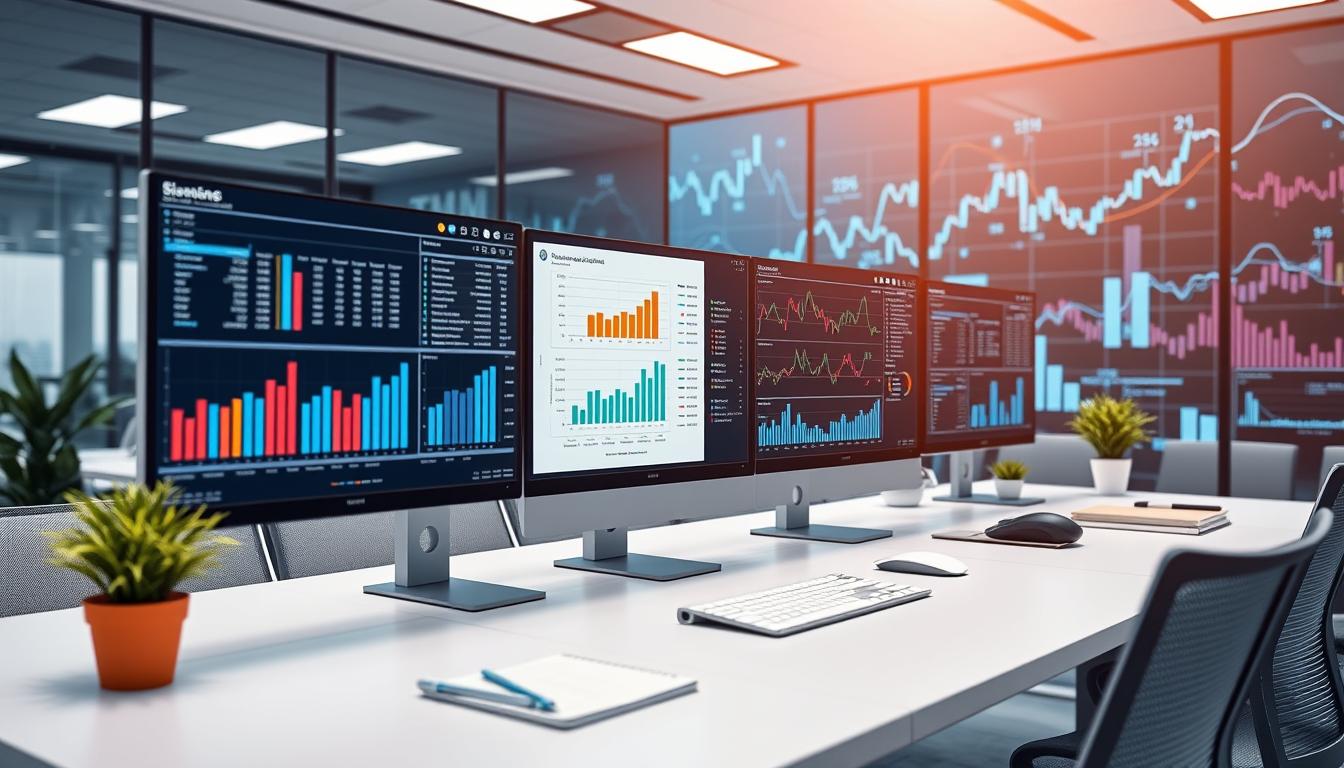Digital accounting is a big game-changer. It’s changing how businesses handle their money. Financial automation brings efficiency, accuracy, and cost savings. It helps companies make their bookkeeping better and improve their accounting.
Accounting pros are now using automation to change their work they’re moving away from manual tasks like data entry and reconciliations. With new tech, businesses can automate tasks like invoicing, payroll, expense tracking, and tax prep.
This move to digital accounting and financial automation boosts accounting efficiency. It also makes streamlined bookkeeping easier. This helps companies stay financially healthy and make better decisions.
We look at how accounting automation has grown we’ll talk about why it’s good for businesses and how to use it well. Join us to learn how digital accounting and financial automation can make your accounting better, more efficient, and strategic.
Understanding the Evolution of Accounting Automation
The world of accounting has changed a lot over time. It moved from manual bookkeeping to advanced digital tools. This change aimed to make things more efficient, accurate, and productive.
From Manual Bookkeeping to Digital Solutions
Before, businesses used manual methods for accounting. They recorded transactions in ledgers and journals. This was slow, prone to errors, and took a lot of time.
But, with the help of computers and automated bookkeeping, things changed. This new technology made accounting faster and more accurate.
Key Milestones in Accounting Technology
- The introduction of electronic spreadsheets, such as Microsoft Excel, in the late 1970s, which allowed for digital record-keeping and calculations.
- The development of specialized accounting software packages in the 1980s, providing businesses with integrated solutions for managing their financial data.
- The emergence of cloud-based accounting platforms in the early 2000s, enabling remote access, real-time data processing, and collaboration.
- The integration of artificial intelligence (AI) and machine learning (ML) in recent years, automating various accounting tasks and enhancing data analysis capabilities.
Current State of Automated Accounting
Now, automated accounting solutions are used by businesses everywhere. These tools use new technologies to make things faster, less error-prone, and more insightful. They help businesses make better decisions.
Automated bookkeeping has made finance departments more efficient. It lets them focus on growing the business instead of just keeping records.
The Business Case for Automation in Accounting
Accounting automation is a must. It helps companies streamline their finances, save money and gain insights for better decisions.
One big benefit of accounting automation is how it boosts accuracy and efficiency. Automated systems cut down on errors, keeping financial records precise and current. This lets accounting teams focus on big-picture tasks, not just routine work.
The ROI of automated finance is also high. Automating tasks like invoicing and payroll saves time and money. This means businesses can spend more on strategic goals, leading to better financial health.
Automated systems also give businesses real-time financial data. This helps finance teams make smart, timely decisions. They can spot trends, seize opportunities, and stay ahead in the market.
In short, the business case for automation in accounting is strong. Digital solutions make finances smoother, cut costs, and give companies an edge. As business speeds up, accounting automation will be key to success for all sizes of organizations.
Essential Tools and Software for Accounting Automation
In today’s fast-changing world of accounting, using automated solutions is key for businesses. They help make processes smoother and more efficient. Cloud-based platforms and AI tools are changing how companies handle their money.
Cloud-Based Accounting Platforms
Cloud-based accounting platforms are a big deal now. They offer secure, easy-to-use, and grow-with-you solutions. QuickBooks Online and Xero are examples that make tasks like invoicing and expense tracking easier. They also let teams work together in real-time, no matter where they are.
AI-Powered Bookkeeping Solutions
AI has changed bookkeeping for businesses. Tools like Botkeeper and Autofy use smart tech to do tasks like data entry and transaction checks. This means accountants can spend more time on important tasks, like planning and advice.
Integration and API Capabilities
Being able to link accounting software with other apps is important. Many top tools now have strong API features. This lets data flow smoothly between systems, like CRM and payroll apps. It makes workflows better, cuts down on manual work, and gives a clear picture of finances.
Using these key accounting tools and tech can help businesses grow. They make operations more efficient, accurate, and strategic. This leads to better financial health in the digital world.
Key Processes Ready for Automation
In the world of accounting, automation is changing the game. It makes important tasks easier and faster. Many key accounting processes are ready to be automated, changing how businesses work.
Automated invoicing is a big area for change. It cuts down on manual work, mistakes, and wait times for payments. This saves time, money, and makes customers happier.
Payroll automation is also a big win. It makes handling pay, taxes, and benefits easier. This means less work for your team and more time for important tasks.
Expense management software is another key tool. It makes tracking and paying for employee expenses easier. This helps control costs, follow rules, and understand finances better.
These are just a few areas where automation can make a big difference. Using technology can make businesses more efficient, accurate, and strategic. This helps them succeed in a tough market.
Implementation Strategies for Accounting Automation
Starting accounting automation is a big step for your finance team. It can make your work more efficient and productive. To make this change smoothly, you need a good plan. This part will show you how to set up your accounting automation roadmap.
Assessment and Planning Phase
The first thing to do is check your current processes. Look for areas that can be automated. Think about your business needs, the software you need, and how it will affect your company. A good plan will help you meet your finance goals.
Staff Training Requirements
Getting your team ready for accounting automation is key. Offer training that helps them use the new systems well. You might need workshops, online tutorials, or one-on-one help. This way, your team can easily move to the new workflows.
Timeline and Milestone Setting
Having a clear plan and milestones is important. Create a plan to introduce the new systems step by step. This lets you test and improve without upsetting your work flow.
By following these steps, you can make the most of accounting automation. Remember, good planning, training, and a clear timeline are the secrets to success. They help you smoothly move to automated accounting systems.
Overcoming Common Automation Challenges
Starting on the journey to accounting automation can be exciting but also comes with challenges. Companies face obstacles like accounting automation obstacles, data migration issues, and resistance to change in finance.
One big challenge is moving data from old systems to new ones. Switching to cloud-based platforms can be tough. It’s important to make sure all financial data is moved safely and correctly. A detailed plan and step-by-step actions help avoid problems during this process.
Another issue is getting employees to accept new ways of doing things. People who have always done things a certain way might be slow to change. To overcome this, it’s key to have a good plan for change. This includes clear communication, training, and showing how automation helps.
- Getting new accounting software to work with old systems can also be hard. It’s important to keep data flowing smoothly and not disrupt daily work.
- Getting leaders and others to agree to change is also a big challenge. It often takes a lot of money and a change in how the company thinks.
- Keeping up with rules and protecting data is always a challenge. This requires strong security and regular checks to make sure everything is okay.
By tackling these accounting automation obstacles head-on, companies can move forward with confidence. They can enjoy the benefits of being more efficient, saving money, and staying ahead of the competition.
Measuring ROI and Performance Metrics
Measuring the return on investment (ROI) and evaluating performance metrics is key in accounting automation. By looking at financial indicators and cost-benefit analysis, you can understand the value of your investments. This helps you see the long-term benefits of your automation efforts.
Key Performance Indicators
To measure the impact of accounting automation, track important metrics. These include:
- Time savings in manual data entry and reconciliation
- Reduction in accounting errors and rework
- Improvements in financial reporting accuracy and timeliness
- Increased productivity and efficiency of your accounting team
- Cost savings from reduced administrative expenses
Cost-Benefit Analysis Methods
Doing a detailed cost-benefit analysis is vital for evaluating accounting automation. This analysis should look at the initial investment, ongoing costs, and expected savings. It helps you see if the investment is worth it in the long run.
Long-term Value Assessment
It’s important to look at the long-term value of your automation efforts. This means checking how it affects your financial performance. Look at things like better cash flow, lower expenses, and better decision-making.
By tracking and analyzing these metrics, you can make smart choices about your accounting automation strategy. This ensures you get a good return on your investment.
Security and Compliance Considerations
The accounting industry is moving towards automation. This means keeping financial data safe and following rules is more important than ever. It’s key to protect sensitive info and meet legal standards.
Data protection is a big worry with automated accounting. It needs strong encryption, safe storage, and who can access it. Companies must use multi-factor authentication, keep software up-to-date, and have good backup plans. This helps prevent data breaches and unauthorized access.
Following rules is also vital in automated accounting. Businesses must stick to financial reporting standards, data privacy laws, and industry rules. Automated systems should work well with these rules, keeping financial records accurate and reliable.
- Implement strong encryption and access controls to protect accounting data security
- Ensure financial compliance in automation by aligning with regulatory standards
- Develop comprehensive cybersecurity measures to safeguard the finance department
By focusing on security and following rules, businesses can fully use automated accounting. They can keep their financial info safe and private. It’s important to be proactive in protecting data and following rules in this changing field.
Future Trends in Accounting Automation
The world of accounting is changing fast. New technologies like blockchain and advanced analytics are set to transform the field. These changes will make accounting more efficient and strategic.
Blockchain is becoming a big deal in accounting. It makes financial transactions safe, open, and easy to track. This means accounting tasks like checking records and managing contracts will change a lot.
Artificial intelligence (AI) and machine learning are also making waves. They can do boring tasks like data entry and expense tracking. This lets accountants focus on important work. Plus, they can understand financial data better, helping businesses make smarter choices.
- Blockchain in accounting: Enhancing the reliability and transparency of financial records
- AI and machine learning: Automating repetitive tasks and providing data-driven insights
- Robotic Process Automation (RPA): Streamlining back-office accounting functions
- Cloud-based accounting platforms: Enabling real-time data access and collaboration
- Predictive analytics: Forecasting financial trends and identifying opportunities
These new technologies promise a future where accounting is more efficient and strategic. By using these tools, businesses can stay ahead in the financial world.
Conclusion
Accounting automation has changed the financial world, bringing many benefits to businesses. It makes routine tasks easier, improves data accuracy, and offers deep insights. These digital tools are key for any accounting team ready for the future.
By using automation, companies can work better and faster. This lets their skilled accounting team focus on important decisions and tasks. Moving to digital finance transformation helps businesses stay ahead in today’s fast-changing market.
As technology keeps improving, accounting automation benefits and future-ready accounting will change how we manage money. Businesses that use these new tools will do well in the future. They will lead in a world that’s more digital every day.



